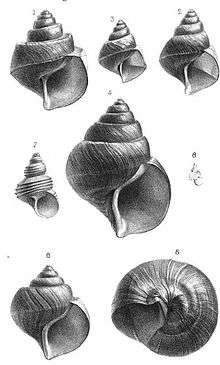Neothauma
| Neothauma | |
|---|---|
 | |
| shell of Neothauma tanganyicense | |
| Scientific classification | |
| Kingdom: | Animalia |
| Phylum: | Mollusca |
| Class: | Gastropoda |
| (unranked): | clade Caenogastropoda informal group Architaenioglossa |
| Superfamily: | Viviparoidea |
| Family: | Viviparidae |
| Genus: | Neothauma E. A. Smith, 1880[2] |
| Species: | N. tanganyicense |
| Binomial name | |
| Neothauma tanganyicense E. A. Smith, 1880[2] | |
Neothauma tanganyicense is a species of freshwater snail with a gill and an operculum, an aquatic gastropod mollusc in the family Viviparidae.
Distribution
This freshwater snail is only found in Lake Tanganyika, where it is the largest gastropod, and occurs in all four of the bordering countries — Burundi, the Democratic Republic of the Congo, Tanzania, and Zambia — although fossil shells have been discovered at Lake Edward and in the Lake Albert basin.[1]
The type locality is the East shore of Lake Tanganyika, at Ujiji.[4]

History

The genus Neothauma previously contained several species, but most were reassigned to other genera.[5]
Description
The width of the shell is 46 mm (1.8 in).[4] The height of the shell is 60 mm (2.4 in).[4]
Ecology
This species lives in depths of up to 65 m (213 ft).[4] There is conflicting information relating to its feeding behavior, with one study referring to it as a detritus-feeder,[6] another saying that it actively preys on endobenthic organisms,[7] and finally that it feeds on particulate organic filtered while the snail is buried.[8]
The shells of dead Neothauma tanganyicense often form carpets over large areas, and are used by a number of other animals, such as cichlid fish (shell dwellers),[9] and freshwater crabs of the genus Platythelphusa.[10] Juvenile snails live in the sediment in order to avoid predators.[4]
References
- 1 2 F. Nicayenzi; C. Ngereza & C. N. Lange (2010). "Neothauma tanganyicense". The IUCN Red List of Threatened Species. IUCN. 2010: e.T14569A4445054. doi:10.2305/IUCN.UK.2010-3.RLTS.T14569A4445054.en. Retrieved 12 January 2018.
- 1 2 Smith E. A. (1880). "On the shells of Lake Tanganyika and of the neighbourhood of Ujiji, central Africa". Proceedings of the Zoological Society of London 1880: 344-352. Page 349. Plate 31.
- ↑ Mita E. Sengupta; Thomas K. Kristensen; Henry Madsen & Aslak Jørgensen (2009). "Molecular phylogenetic investigations of the Viviparidae (Gastropoda: Caenogastropoda) in the lakes of the Rift Valley area of Africa". Molecular Phylogenetics and Evolution. 52 (3): 797–805. doi:10.1016/j.ympev.2009.05.007. PMID 19435609.
- 1 2 3 4 5 6 Brown D. S. (1994). Freshwater Snails of Africa and their Medical Importance. Taylor & Francis. ISBN 0-7484-0026-5.
- ↑ Bourguignat, Jules René (1888-01-01). Iconographie malacologique des animaux mollusques fluviatiles du Lac Tanganika (in French). Impr. Crété.
- ↑ Palacios-Fest, M.R.; S.R. Alin; A.S. Cohen; B. Tanner; H. Heuser (2005). "Paleolimnological investigations of anthropogenic environmental change in Lake Tanganyika: IV. Lacustrine paleoecology". Journal of Paleolimnology. 34: 51–71. doi:10.1007/s10933-005-2397-1.
- ↑ Van Damme, D.; Pickford, M. (1998). "The late Cenozoic Viviparidae (Mollusca, Gastropoda) of the Albertine Rift Valley". Hydrobiologia. 390 (1): 171–217. doi:10.1023/A:1003518218109.
- ↑ West, K.; Cohen, A.; Baron, M. (1991). "Morphology and behavior of crabs and gastropods from Lake Tanganyika, Africa: Implications for lacustrine predator-prey coevolution". Evolution. 45 (3): 589–607. doi:10.1111/j.1558-5646.1991.tb04331.x.
- ↑ Stephan Koblmüller; Nina Duftner; Kristina M Sefc; Mitsuto Aibara; Martina Stipacek; Michel Blanc; Bernd Egger & Christian Sturmbauer (2007). "Reticulate phylogeny of gastropod-shell-breeding cichlids from Lake Tanganyika — the result of repeated introgressive hybridization". BMC Evolutionary Biology. 7: 7. doi:10.1186/1471-2148-7-7. PMC 1790888. PMID 17254340.
- ↑ N. Cumberlidge; R. von Sternberg; I. R. Bills & H. Martin (1999). "A revision of the genus Platythelphusa A. Milne-Edwards, 1887 from Lake Tanganyika, East Africa (Decapoda: Potamoidea: Platythelphusidae)". Journal of Natural History. 33: 1487–1512. doi:10.1080/002229399299860.
